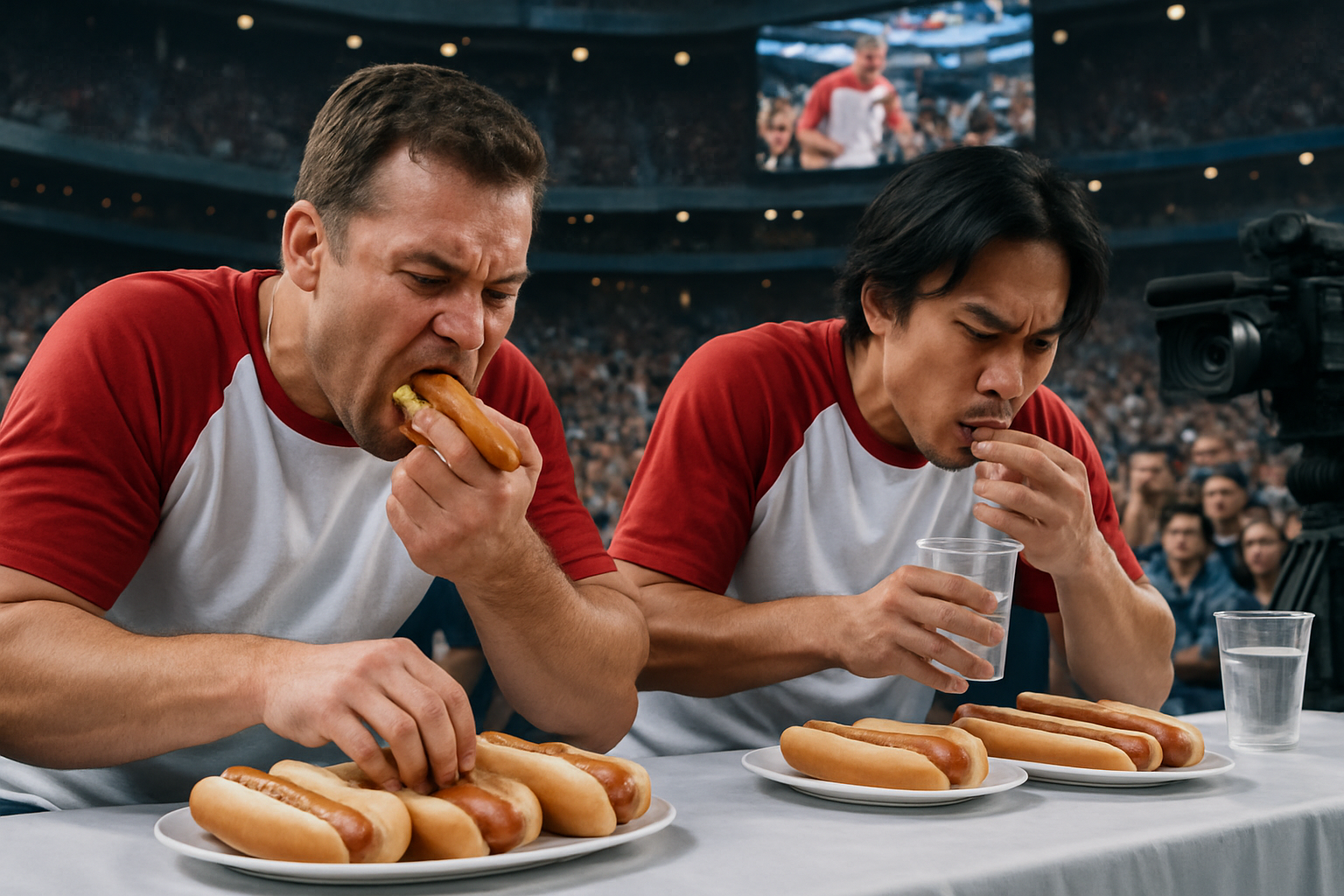Competitive Eating: The Gastronomic Sport Pushing Human Limits
In the realm of unconventional athletics, competitive eating stands out as a captivating fusion of gastronomy and sport. This unique discipline pushes the boundaries of human physiology, challenging participants to consume vast quantities of food in record time. From hot dogs to oysters, competitive eaters train rigorously to expand their stomach capacity and master techniques that allow them to swallow faster than the average person can chew. As we delve into this fascinating world, we'll explore the history, science, and controversy surrounding this growing phenomenon that has captured the attention of millions worldwide.

The sport gained significant traction in the 1990s with the formation of the International Federation of Competitive Eating (IFOCE) in 1997, now known as Major League Eating (MLE). This organization brought structure, rules, and professionalism to the sport, elevating it from a novelty act to a legitimate competitive pursuit. The MLE oversees numerous events throughout the year, ranging from regional qualifiers to world championship contests.
As the sport evolved, so did the techniques and strategies employed by competitors. Early eaters relied primarily on sheer willpower and stomach capacity. Today’s top-ranked eaters employ sophisticated methods such as the “Solomon Method” (separating hot dogs from buns) and the “Kobayashi Shake” (a rapid torso wiggle to help food settle), named after Takeru Kobayashi, one of the sport’s most iconic figures.
The Physiology of Competitive Eating
At its core, competitive eating is a test of human physiological limits. The average human stomach can comfortably hold about 1 liter of food, expanding to around 4 liters when pushed to its maximum. However, competitive eaters train their bodies to accommodate much more. Through gradual stomach stretching exercises and carefully planned diets, top eaters can expand their stomachs to hold up to 8 liters or more.
This extreme stomach expansion doesn’t come without risks. Gastric rupture, though rare, is a potentially life-threatening condition that can occur when the stomach is overfilled. To mitigate this risk, competitive eaters often train by consuming large volumes of low-calorie foods like cabbage or watermelon, which allow for expansion without the caloric load of competition foods.
Beyond stomach capacity, successful competitive eaters must also contend with the gag reflex, a protective mechanism designed to prevent choking. Through practice and mental discipline, many eaters learn to suppress this reflex, allowing them to consume food at speeds that would trigger involuntary regurgitation in untrained individuals.
The body’s ability to process such large quantities of food in a short time is another physiological challenge. The pancreas must produce extraordinary amounts of digestive enzymes, while the liver works overtime to process the influx of nutrients. This puts significant stress on the digestive system and can lead to long-term health consequences if not managed carefully.
Training Regimens and Techniques
Becoming a top-tier competitive eater requires dedication and a structured training approach. Many professional eaters follow rigorous schedules that combine physical conditioning, stomach stretching exercises, and practice events. A typical training regimen might include:
- Cardiovascular exercise to maintain overall fitness and metabolism
- Stomach stretching sessions using water or low-calorie foods
- Speed eating drills to improve technique and pace
- Mental visualization and meditation to prepare for the psychological aspects of competition
One popular training technique is the “water training” method, where competitors drink large volumes of water in short periods to expand their stomachs safely. This allows for increased capacity without the caloric intake associated with food-based training.
Competitive eaters also focus on developing specific techniques for different types of foods. For example, hot dog eating requires a different approach than oyster consumption. Joey Chestnut, the current world record holder for hot dogs, has perfected a technique that involves breaking each hot dog in half, compressing it in his hands, and swallowing it with minimal chewing.
Breathing techniques play a crucial role as well. Many eaters practice controlled breathing to manage their heart rate and oxygen intake during competitions. This helps prevent dizziness and maintains focus throughout the event.
The Competitive Eating Circuit
The world of competitive eating has grown into a global phenomenon, with events held across North America, Europe, and Asia. Major League Eating sanctions over 80 events annually, with prize purses ranging from a few hundred dollars to tens of thousands for major championships.
The Nathan’s Famous Hot Dog Eating Contest remains the pinnacle of the sport, with the men’s and women’s champions each receiving a $10,000 prize and the coveted “Mustard Belt.” Other notable events include:
- The World Oyster Eating Championship in New Orleans
- The World Pie Eating Championship in Wigan, England
- The Krystal Square Off World Hamburger Eating Championship
- The World Poutine Eating Championship in Toronto
These events attract a diverse array of competitors, from dedicated professionals to ambitious amateurs looking to make their mark. The atmosphere at major competitions is electric, with crowds cheering on their favorite eaters and announcers providing play-by-play commentary on the gastronomic feats unfolding before them.
Competitive eating has also found a home on television, with events broadcast on major sports networks and dedicated programs showcasing the personalities and stories behind the competitors. This media exposure has helped elevate the profile of the sport and its top athletes, turning some into minor celebrities.
Records and Notable Achievements
The world of competitive eating is filled with awe-inspiring records that showcase the incredible capabilities of the human body. Some of the most notable achievements include:
- Joey Chestnut’s record of 76 hot dogs and buns consumed in 10 minutes at the 2021 Nathan’s Famous Hot Dog Eating Contest
- Miki Sudo’s 48.5 hot dogs and buns in 10 minutes, setting the women’s record in 2020
- Patrick Bertoletti’s 444 oysters consumed in 8 minutes at the 2007 Acme World Oyster Eating Championship
- Takeru Kobayashi’s 97 hamburgers in 8 minutes at the Krystal Square Off World Hamburger Eating Championship
These records are constantly being challenged and broken as competitors push themselves to new limits. The evolution of techniques and training methods continues to raise the bar for what is possible in the sport.
Health Concerns and Controversies
While competitive eating has grown in popularity, it has not been without its critics. Health professionals have raised concerns about the potential long-term effects of repeatedly consuming such large quantities of food in short periods. Some of the health risks associated with competitive eating include:
- Gastroparesis: A condition where the stomach takes too long to empty its contents
- Obesity: Despite their ability to consume large amounts of food, many competitive eaters struggle with weight management outside of competition
- Digestive issues: Chronic indigestion, acid reflux, and other gastrointestinal problems
- Choking: The rapid consumption of food increases the risk of choking during competitions
To address these concerns, Major League Eating has implemented safety measures, including having medical personnel on standby at events and enforcing strict qualification requirements for participants. However, debate continues about the ethical implications of promoting extreme eating as a sport.
Another controversy surrounding competitive eating is the issue of food waste. Critics argue that these events promote overconsumption in a world where food insecurity remains a significant problem. In response, some organizations have begun partnering with food banks and implementing waste reduction strategies at their events.
The Psychology of Competitive Eating
The mental aspect of competitive eating is often overlooked but plays a crucial role in success. Competitors must overcome natural instincts and mental barriers to push their bodies to extremes. Sports psychologists working with competitive eaters focus on several key areas:
- Visualization techniques to prepare for the physical and mental challenges of an event
- Stress management strategies to maintain composure under pressure
- Goal-setting and motivation to drive consistent training and improvement
- Mindfulness practices to stay present and focused during competitions
Many top eaters describe entering a “zone” during competitions, where they can block out distractions and focus solely on the task at hand. This mental state allows them to push through physical discomfort and maintain their pace throughout the event.
The psychological toll of competitive eating can be significant. Competitors often face societal stigma and must grapple with the potential health consequences of their chosen sport. Balancing the drive to succeed with long-term well-being is an ongoing challenge for many in the field.
The Future of Competitive Eating
As competitive eating continues to evolve, several trends are shaping its future:
- Increased focus on athlete health and safety, with more stringent medical screenings and monitoring
- Diversification of events, including more plant-based and health-conscious competitions
- Integration of technology, such as smart scales and real-time data tracking during events
- Expansion into new international markets, particularly in Asia and Europe
- Greater emphasis on the entertainment aspect, with more engaging presentation and storytelling around competitions
The sport is also seeing a shift towards more sustainable practices, with organizers exploring ways to reduce food waste and promote responsible consumption. Some events now feature plant-based alternatives or partner with food recovery programs to donate excess food to those in need.
As competitive eating gains recognition as a legitimate sport, there is growing interest in studying the physiological and psychological aspects of extreme eating. Researchers are exploring the potential applications of insights gained from competitive eaters in fields such as medicine and nutrition.
Conclusion
Competitive eating stands as a testament to the extraordinary capabilities of the human body and mind. From its humble beginnings at county fairs to its current status as a globally recognized sport, it has captivated audiences and pushed the boundaries of what we thought possible. While controversies and health concerns persist, the dedication and skill of competitive eaters continue to inspire and amaze.
As the sport evolves, it faces the challenge of balancing spectacle with responsibility, entertainment with ethics. The future of competitive eating will likely see a greater emphasis on athlete welfare, sustainable practices, and scientific understanding of extreme eating’s effects on the human body.
Whether viewed as a fascinating display of human potential or a concerning spectacle of excess, competitive eating has undeniably carved out its place in the world of sports and popular culture. As it moves forward, the sport will continue to challenge our perceptions of human limits and the relationship between food and competition.





